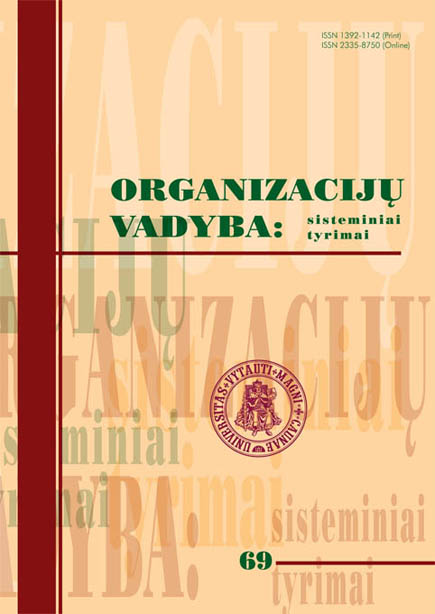Darbuotojo gerovė ir pozityvi darbo aplinka: integruotas teorinis modelis
Employee well-being and positive work environment: integrated theoretical model
Author(s): Giedrė Genevičiūtė-Janonienė, Aistė Pranckevičienė, Loreta Bukšnytė-Marmienė, Loreta GustainienėSubject(s): Economy
Published by: Vytauto Didžiojo Universitetas
Keywords: Darbuotojų gerovė; Pozityvi darbo aplinka; Psichosocialiniai veiksniai; Modelis; Employee well-being; Positive work environment; Psychosocial factors; Model
Summary/Abstract: Straipsnyje pristatomas integruotas teorinis darbuotojo gerovės ir palankios darbo aplinkos modelis, pagrįstas pozityviosios psichologijos idėjomis ir tyrimais, kuriuo siekiama prisidėti prie pozityvių veiksnių darbo aplinkoje plėtotės. Business sector in developed countries faces financial losses related to health problems of their employees. These expenses are related to economic as well as to human losses. Therefore it is important to enhance employee well-being in order to prevent these problems. Traditional understanding of health mostly stresses the problem solving strategy, thus neglecting the search of factors, strengthening both the individual and the organization well-being. Compared to other EU countries, a subjective happiness level in Lithuania is rather low, therefore, a thorough study of positive psychological and social factors, encouraging personality development applicable to an organizational setting, creates a new impulse for the search of a harmonious combination of the person and the organization. Having this in mind the project aiming at developing a comprehensive model of the employee and the workplace well-being, based on biopsychosocial understanding of health and promoting positive healthrelated factors in an organization, was initiated. The object of the study is positive psychosocial factors affecting the employee and the workplace well-being. The present article presents a generalised view on the benefits of the employee and his workplace well-being interventions based on a thorough analysis of research literature of foreign and Lithuanian scientists. The authors introduce an Integrated Theoretical Model of Employee Well-being and Positive Work Environment. The model was formed based on the literature analysis. Publications for the analysis were collected from databases using keywords such as ‘organization’, ‘well-being’, ‘wellness’. The model is based on the biopsychosocial understanding of health including the interplay of healthrelated biological, social and psychological factors, as well as emphasizing promotion of the health-affecting positive psychosocial factors. The methods of the study were analysis of scientific literature, expert survey, comparison and generalisation.
Journal: Organizacijų vadyba: sisteminiai tyrimai
- Issue Year: 2014
- Issue No: 69
- Page Range: 37-53
- Page Count: 17
- Language: Lithuanian

